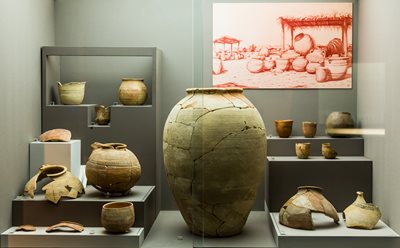About The Museum
Sharjah Archaeology Museum first opened its doors in 1993. It moved to its current location on May 10, 1997.
Why you should visit Sharjah Archaeology Museum
This museum offers you the opportunity to explore the rich heritage and deep-rooted history of Sharjah. The reports of many excavation expeditions showed that humans have settled in Sharjah for a period of not less than 125.000 years. The museum sheds light on the lifestyle of the region’s inhabitants from the stone, modern, and the following ages until the rise of Islam.
Admire an authentic history
The museum contains all the archaeological artifacts that were discovered in Sharjah. The mission of the museum is to preserve, interpret, and exhibit all the artifacts that have been found in Sharjah since the beginning of the excavations in 1973 up until now. The continuous excavations showed that Sharjah boasts a proud, rich deep-rooted history. Settlements and villages were built on its land thousands of years ago.
Visitors get the chance to learn about the civilizations that developed in the region since the Stone Age up until today through the artifacts, currencies, jewelry, pottery and ancient weapons showcased in the museum. The archaeological findings reveal the connections and relations between Sharjah inhabitants and their neighbours in the Arabian Peninsula, as well as with other civilizations. They also show the expansion of commercial relationships from the east of the Indus Valley to the west of the Mediterranean islands.
Explore the tombs, cemeteries and houses through the models displayed in the museum, and learn about the first forms of writing which appeared in this area more than 2500 years ago.
Highlights from the collection
-
Ceramic Dome (900 - 600 BC): A ceramic dome with holes and a statue of a bull; it was probably a censer’s lid. It was discovered on Muweilah site which dates back to the Iron age. This dome provides a proof of the commercial relations with Yemen BC. This piece is displayed in the Iron Age Hall.
- Golden Bridle (150 BC - 200 AD): This golden bridle was found buried with the remains of a horse and a camel in Mleiha by a local excavation team. This collectible represents the wealthy lifestyle some of the Mleiha inhabitants enjoyed during that period. This piece is displayed in the Greater Arabian Region Hall.
- Camel Statue (900 - 600 BC): This ceramic camel statue, found in Muweilah, proves that man was able to domesticate camels in 1000 BC through the items (either a saddle or loads) the camel carries on its back. Camels’ domestication provided the opportunity to expand incense trade between Yemen, and north and east of the Arabian Peninsula through camel caravans that travelled long distances carrying goods. This piece is displayed in the Iron Age Hall.
- Ivory comb placed inside an alabaster bowl (2200 - 2000 BC): A comb made of ivory and placed in an alabaster bowl, both found in a cemetery in Tell Abraq. The unique tulip flower adorning the comb shows that it was made in Central Asia, although the ivory was probably taken from an Indian elephant. This piece is displayed in the Bronze Age Hall.
Opening Hours
Saturday to Thursday:
8:00 am - 8:00 pm
Friday:
4:00 pm - 8:00 pm
Timings are subject to change during public holidays and Ramadan. For more information call the museum.
Website: wwww.sharjahmuseums.ae


